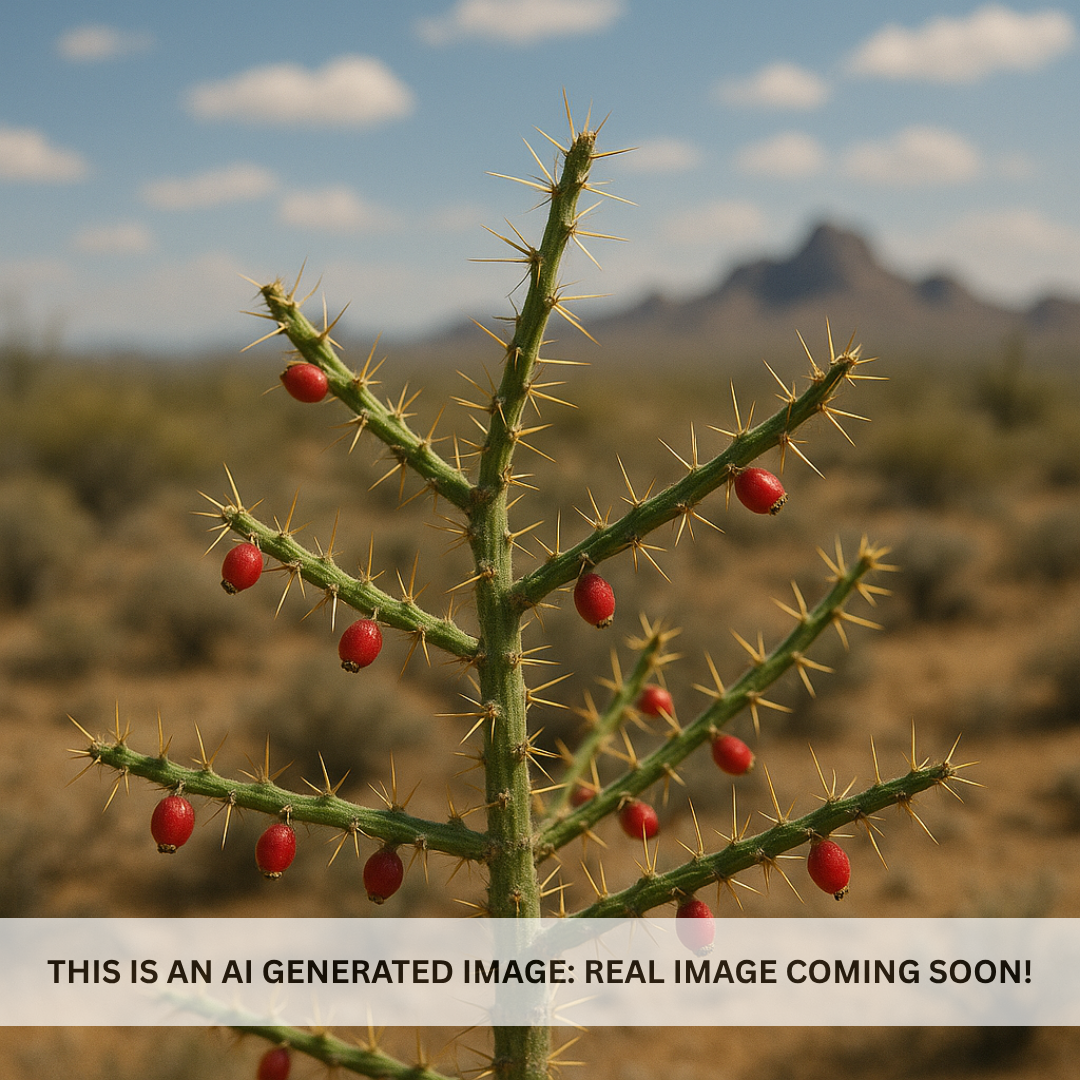My Store
Christmas Cholla
Christmas Cholla
Couldn't load pickup availability
Plant Type: perennial, cactus
Plant Height: 3–5 feet (occasionally up to 6 feet)
Spread: 4–6 feet
Flower Color: yellow-green blooms followed by bright red fruit
Sun Exposure: Full sun
Christmas Cholla (Cylindropuntia leptocaulis): Festive Color and Fine Texture for the Desert Landscape
The Christmas Cholla (Cylindropuntia leptocaulis) is a slender, branching cactus that brings subtle beauty and year-round interest to desert gardens. Named for its vibrant red berries that appear in winter—often during the Christmas season—this species combines a delicate, airy form with bursts of seasonal color. Native to the Sonoran and Chihuahuan deserts, it thrives in Arizona’s arid conditions and offers both visual appeal and ecological value, providing food and shelter for birds and desert wildlife.
Despite its spines, Cylindropuntia leptocaulis has a surprisingly graceful appearance, adding soft texture and intricate branching to modern or naturalistic xeriscapes.
Key Features of Cylindropuntia leptocaulis
Christmas Cholla forms a loosely upright, shrubby structure with thin, pencil-like stems that grow in a dense, tangled pattern. The stems are green and photosynthetic, often appearing leafless but capable of producing tiny, ephemeral leaves during wetter months.
In late spring and early summer, it produces small, pale yellow-green flowers that open along the upper stems. These blooms give way to brilliant red, pear-shaped fruits that persist through fall and winter—sometimes into the next year—creating a striking contrast against the green stems and desert backdrop. The fruit provides winter nourishment for birds such as cactus wrens and doves.
The spines are short and sparse compared to other chollas, making this species less aggressive in appearance and more versatile in design applications.
Growing and Care Tips
Cyindropuntia leptocaulis thrives in full sun and very well-drained soil. It adapts easily to poor, rocky, or sandy soils and is one of the most drought-tolerant cholla species.
During establishment, water every 2–3 weeks in warm weather, allowing the soil to dry completely between waterings. Once established, it requires little to no supplemental irrigation—only during extended droughts.
This cholla is hardy to around 15°F and tolerates both extreme heat and occasional frost. It performs best in open, sunny exposures with excellent air circulation. Pruning is rarely needed, but lower branches can be trimmed to shape the plant or improve visibility of its trunk. Handle with tongs and heavy gloves, as the small barbed spines detach easily.
Landscaping Uses
The Christmas Cholla’s light, wispy structure and bright winter fruit make it a beautiful accent in native desert, xeriscape, or wildlife-friendly gardens. It is especially effective when planted against darker backdrops like rock, stucco, or gravel, which highlight its red fruit and green stems.
It pairs well with Ocotillo, Creosote Bush, Desert Spoon, and smaller barrel cacti, offering contrast in both texture and color. In modern or naturalistic designs, it works beautifully as a mid-height filler plant that maintains visual interest all year long.
Because of its modest size and open form, it can be used near property edges, open courtyards, or in natural washes where wildlife interaction is welcome.
Summary
The Christmas Cholla (Cylindropuntia leptocaulis) adds a touch of holiday color and natural delicacy to Arizona gardens. Its slender green stems, yellow-green blooms, and bright red winter fruit make it a standout species that’s both tough and charming. With minimal water needs and effortless resilience, it brings texture, seasonal beauty, and ecological value to any desert landscape.
Three Timbers Installation Guide (Feel Free to Follow)
Cylindropuntia leptocaulis Planting Guide
Location: Full sun exposure with at least six hours of direct sunlight daily. Choose an open site with good airflow and minimal foot traffic.
Soil: Use fast-draining sandy or rocky soil; avoid heavy or compacted ground. Raised planting areas or mounds help improve drainage and mimic native desert conditions.
Spacing: Space 4–6 feet apart to allow for natural spread and branching.
Planting Depth: Set the base level with the surrounding soil. Avoid burying stem joints or covering with mulch.
Support: Not required; the branching form naturally supports itself.
Watering Guide
Watering After Planting: Water once after planting to settle the soil, then allow it to dry completely before watering again.
When is the Plant Established? The Christmas Cholla is typically established after 6–9 months, when new stem segments or fruits appear regularly.
Watering Once Established: Water sparingly—every 6–8 weeks during extreme drought, and rarely in winter or rainy seasons.
Drip Irrigation Setup: If using drip irrigation, place one low-flow emitter (0.5 gallon per hour) about 6–8 inches from the base. Run infrequently, allowing complete drying between cycles.
General Watering Tips: Avoid overhead watering. Keep decorative rock or gravel mulch several inches from the base to prevent moisture buildup. This species prefers extended dry periods and thrives with minimal care once rooted.
Share














